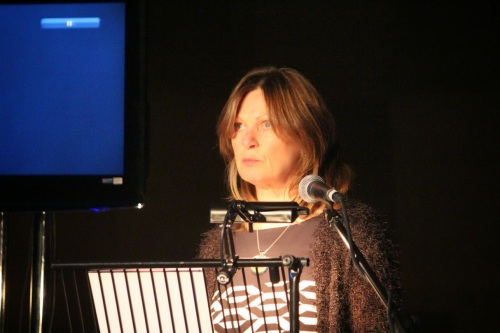Tag Archives: Zones of Avoidance
Zones of Avoidance – Reviews
Dear Maggie
May I congratulate you on Zones of Avoidance, a major work that tells several moving stories and contains many wonderful poems. It was very impressive writing. Very striking lines about the Higher Power, and about the grandchild. The conception and music and staging were well-judged too. Bravo!
George Marsh
Great performance yesterday Maggie. I’m really pleased I went. It is still affecting me now and making me look at my experiences from the parent’s view point. Thank you x
Adam Lewis
Hi Maggie and Mark,
I just wanted to write to congratulate you both on a really extraordinary performance piece.
It was beautifully presented and had a crystal clear narrative. I genuinely think that the total silence of the packed audience
as Maggie left the stage was the greatest compliment we could pay to it. The storyline has been ricocheting around my head and will continue to do so… .
Caroline Sharman, Director of New Theatre Royal.
it was really nice to be there and was a fantastic perfomance from you..as it was very emotional at times and some funny bits ……thanks for letting me be part of the production and really enjoyed it ….x Elliot Cranston (one of the voices)
Thanku Maggie 4 “Zones of aviodance” Today i managed to experience some feelings that I’d actually forgotten I was capable of…… To you, and to everyone who took part, I am truely GRATEFULL – Daniel Scrivener
Can Art nurture Empathy?
WORKING THERAPEUTICALLY WITH ADDICTION
A course funded by Portsmouth City Council for people in recovery from addictions and for those affected by addiction.
One of the requirements of this course was to give a presentation to the rest of the group. Mine was entitled ‘Can Art Nurture Empathy?’ A part of it included this poem that I’d written several years ago:
My Daughter’s Habit
A month’s respite doesn’t stop the heart
tilting in the cradle at the knock,
the scene replayed before I open the door.
I know from her expression what it is she wants,
but still she asks, and I fetch,
like a dog, hand over the score,
notice once more the half-moon scar
on the bone of her cheek.
The night swallows her shadow,
catches my sigh as she walks away.
I lean awhile against the door,
listen as the wind worries the trees,
smother the thought: to press
a pillow against my slipping heart.
(from The Zig Zag Woman, Two Ravens Press 2007)
After listening to the poem, one of the group members told me it was the first time he’d realised what his own mother must have been going through.
When I came on this course I believed I had lost the capacity for hope. As a mother of a child gripped by addiction there seems to be only two options. One, the most natural, is to jump in and rescue; the other is to cut yourself off, to demonise the person you love. I’ve tried both. Neither of them works. If you jump into the well, thinking you can rescue your loved one from drowning, at best all you do is enable them to carry on; at worst you end up drowning with them. Cutting yourself off doesn’t work either – you end up living your life as if it’s inhabited by a ghost.
This course offered a third option. It offered a unique opportunity for mothers, fathers, sons and daughters, to get up close and personal; it offered us an opportunity to face our demons. Of particular interest to me was the course’s existentialist approach. As well as providing us with a thorough understanding of the nature of addiction, it helped to demolish the ‘them and us’ barrier. It helped us to realise that as human beings we all face the same predicament – how to fill the inevitable void – and that we have a choice. We can fill that void with something that does harm to ourselves and to others, or we can fill it with something that, through acts of altruism, enhances the lives of others.
The Peer Recovery Broker scheme offers those in recovery from addiction, and those of affected by it, a tangible opportunity to change, not only our own lives, but the lives of others.
Last month I did something I never dared imagine. I accompanied my daughter on her first visit to Narcotics Anonymous. When it came to the end of the evening devoted to newcomers, my daughter remained silent. I found myself saying: ‘My name’s Maggie. I’m not an addict, but I do like a drink. I’ve come here to support my daughter.’ After that my daughter spoke. I then watched as she walked towards the front to receive her badge of surrender. This course enabled me to regain the capacity for hope.
Writtten in November 2012 (first published in Flagship magazine).
Filed under blog
A Word-Dance into the Void
‘Join the narrator’s quest to discover the lure of psychoactive substances following her daughter’s descent into addiction.
A multimedia live literature production, Zones of Avoidance captures the desperate and surreal mundanity of living with addiction. The show combines the poet’s moving testimony with the voices of addicts in recovery.’
Written and performed by Maggie Sawkins
Directed by Mark Hewitt
Filed under blog
Zones of Avoidance
Why Zones of Avoidance?
I’d been researching about walls as a subject for a series of poems. The largest known wall I discovered is The Coma Wall. It’s 200 million light years away and is the largest known superstructure in the universe. It’s impossible to tell where it ends because the gas and dust from the Milky Way (the Zone of Avoidance) obscures the view.
Thoughts on using wall as (quite an obvious) metaphor.
You can get used to being a wall.
Walls are silent. Walls don’t retaliate. Walls are for leaning against. But if you act like a wall for long enough someone might knock a nail into you; lean something, or someone against you. Might fire a bullet above their head.
That’s the time to wake up. The time to unwall.
Zone of Avoidance as metaphor
A barrier to:
- clarity
- honesty
- intimacy
- pain
which links to my other preoccupation: The Karpman Drama Triangle (persecutor, rescuer, victim) and its relevance to addiction and co-dependency – the subject of this production.
I think I may be mixing metaphors but I hope it’ll all become clear in the end!
Filed under blog








You must be logged in to post a comment.